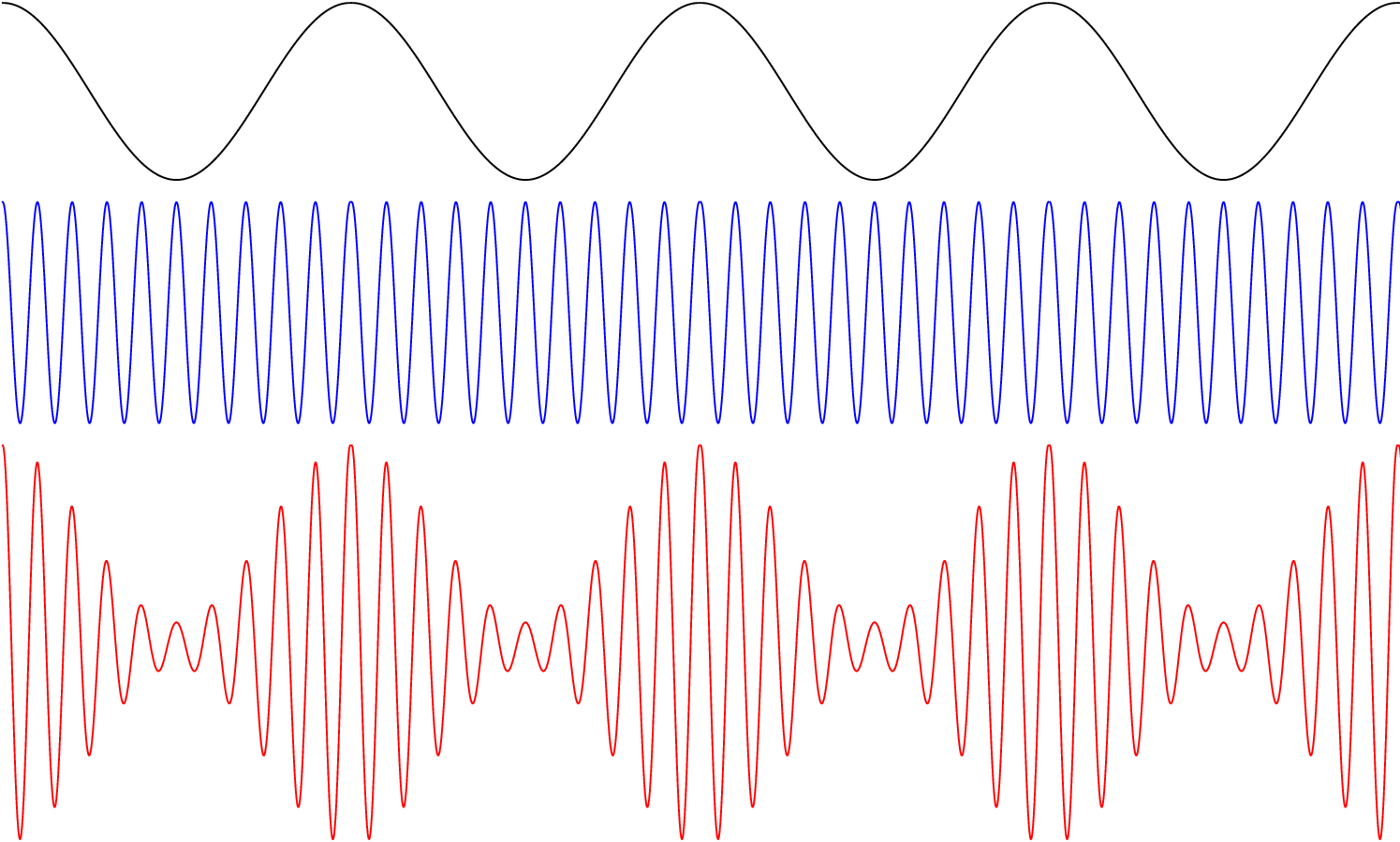Animated cosine waveform with FM modulation using the animate package
You are looking for an AM example. (For FM, see ↗follow-up Q.)
The plotted equations were modified somewhat (acc. to Wikipedia page on ↗Amplitude Modulation).
Here is an approach using the xsavebox package. This saves final PDF file size and a lot of compilation time.
- We save one cycle
[0:pi]of the base signal into anxlrbox, outsideanimateinline. - Then, the animation is created by moving 5 cycles in a window of 4 cycles width.

%%%%%%%%%%%%%%%%%%%%%%%%%%%%%%%%%%%%%%%%%%%%%%%%%%%%%%%%%%%%%
%% uncomment \def\export{} below to export animation
%% to multipage PDF a.pdf and run
%%
%% convert -density 300 -delay 4 -loop 0 -alpha remove a.pdf b.gif
%%
%% to get an animated GIF b.gif at 100/4 = 25 frames per s
%%%%%%%%%%%%%%%%%%%%%%%%%%%%%%%%%%%%%%%%%%%%%%%%%%%%%%%%%%%%%
%\def\export{}
%%%%%%%%%%%%%%%%%%%%%%%%%%%%%%%%%%%%%%%%%%%%%%%%%%%%%%%%%%%%%
\ifdefined\export
\documentclass[export]{standalone}
\else
\documentclass{standalone}
\fi
\usepackage{pgfplots}
\pgfplotsset{compat=newest}
\usepackage{animate}
\usepackage{xsavebox} % xlrbox
\usepackage{calc} % \widthof{...}, \real{...}
\usepackage{amsmath}
\begin{document}
%
%save ONE cycle in an xlrbox
\begin{xlrbox}{OneCycle}
\begin{tikzpicture}
\begin{axis}[
hide axis,
x=1cm,y=1cm,
/tikz/line cap=rect, /tikz/line join=round
]
\addplot[domain=0:pi,black,samples=250] {0.8*cos(x*2*180/pi)};
\addplot[domain=0:pi,blue,samples=500] {cos(x*20*180/pi)-2};
\addplot[domain=0:pi,red,samples=500] {(1+0.8*cos(x*2*180/pi))*cos(x*20*180/pi)-5};
\end{axis}
\end{tikzpicture}
\end{xlrbox}%
%
\begin{animateinline}[controls,loop]{10}
\multiframe{18}{i=0+1}{
\makebox[\widthof{\theOneCycle}*\real{4}][l]{% window = FOUR cycles
\makebox[\widthof{\theOneCycle}/\real{18}*\real{-\i}]{}% offset
\theOneCycle\theOneCycle\theOneCycle\theOneCycle\theOneCycle% moving FIVE cycles
}
}
\end{animateinline}
\end{document}
Like this? I added the controls for debugging, you can set step or autoplay as you wish.
\documentclass{article}
\usepackage{pgfplots}
\pgfplotsset{compat=newest}
\usepackage{tikz}
\usepackage{media9}
\usepackage{animate}[2014/11/27]
\usepackage{amsmath}
\tikzset{
declare function={
carrier(\t) = cos(\t);
modulator(\t) = cos(6*\t);
},
}
\pgfmathsetmacro\StepSize{10}
\pgfmathtruncatemacro\NumFrames{360/\StepSize}
\newcommand{\drawModulatedAM}[1]{%
\begin{tikzpicture}
\pgfmathsetmacro\PhaseShift{#1*\StepSize}
\begin{axis}[
hide axis,
scale only axis,
width = 12cm,
height = 6cm,
xmin=-360,
xmax=360,
]
\addplot[domain=-360:360,black,samples=101] {carrier(x+\PhaseShift)};
\addplot[domain=-360:360,blue,samples=501] {modulator(x+\PhaseShift)-2.5};
\addplot[domain=-360:360,red,samples=501] {modulator(x+\PhaseShift)*carrier(x+\PhaseShift) - 5};
\end{axis}
\end{tikzpicture}%
}
\begin{document}
\begin{animateinline}[label=graph_switch,controls]{10}
\multiframe{\NumFrames}{iFrame=0+1}{\drawModulatedAM{\iFrame}}
\end{animateinline}
\end{document}
Result:
